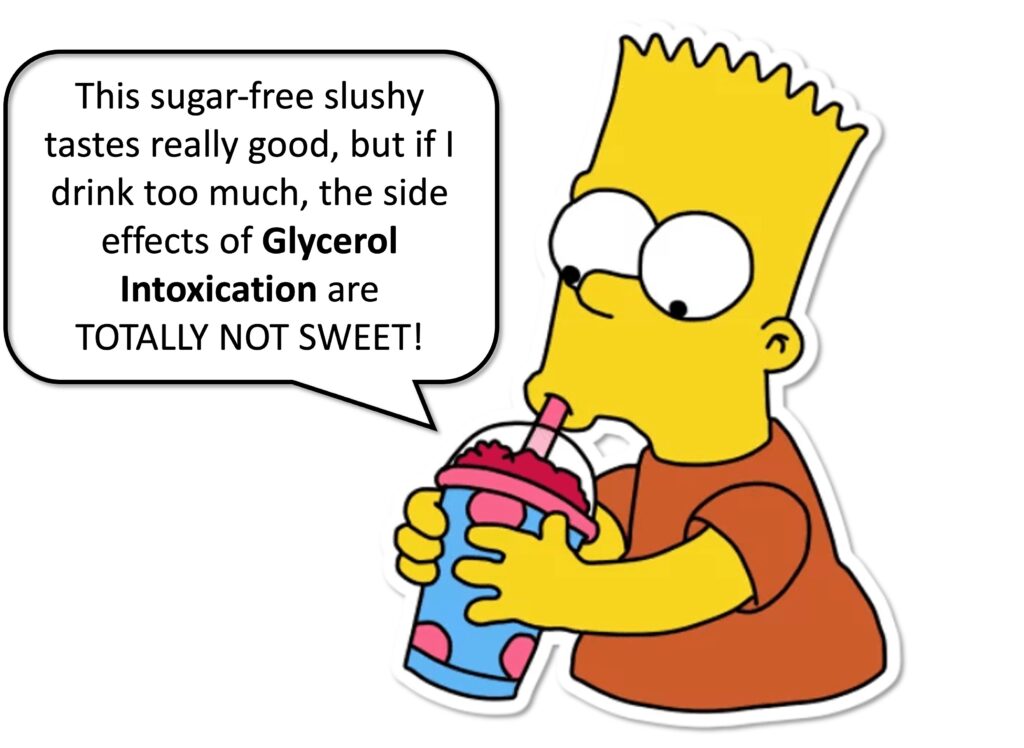Slushy Ingestion and Glycerol Intoxication Syndrome

As I sit in the ED at 3 am, enjoying my root beer slushy and contemplating the end of summer, I recall a recent article describing glycerol intoxication in children who consumed sugar-free slush beverages. Of all the things that children, ruled by their underdeveloped prefrontal cortices, put in their mouths (i.e. button batteries, lead foreign bodies, vape juice, detergent pods, ethanol, etc.), most would not expect a quintessentially summer beverage to lead to severe consequences. This serves as a reminder that we must “stay vigilant“, as the good Dr. Fox would say. So, grab a slushy (preferably not sugar free), pull up a seat, and let’s go on a journey to learn more about glycerol intoxication – Beware the Slush!!!
Glycerol Intoxication Syndrome – What is Glycerol?
- Glycerol is also known as glycerin
- Natural compound in lipids
- Endogenous metabolite in mammals
- When consumed by mouth, it is easily absorbed from the GI tract
- First pass metabolism through the liver
- The body uses glycerol to make ATP through glycolysis
- Can be substituted for use in gluconeogenesis and lipogenesis
- Excretion
- Glycerol is oxidized and exhaled as carbon dioxide
- Only very little excreted in the urine or stool
- After high doses, it can be detected in the urine soon after administration
Glycerol Intoxication Syndrome – Glycerol Uses
- Can have therapeutic use
- Oral or IV administration
- Mobilizes edema by inducing an osmotic gradient
- Reduces intraocular pressure in glaucoma
- Used as a food additive
- Approved by the European Food Safety Authority
- In the past, has not been shown to cause significant clinical symptoms of intoxication or toxicity
- You can find glycerol in flavored drinks, sauces, breads/rolls, breath mints/gum, and edible ices
- Prevalent in sugar-free ice beverages
- Helps maintain appropriate texture in the absence of sugar and high fructose corn syrup
- Dose of glycerol required to cause adverse effects is 125 mg/kg
- Toddler need only consume as little as 50 – 220 mL of a slush beverage to experience symptoms
- Of note, standard size for this drink in the UK is 500 mL! (Probably same or higher in the US)
Glycerol Intoxication Syndrome – Symptoms
- Hypoglycemia
- 2025 case series from the UK with 21 children referred to a metabolic service after being diagnosed with slush ice drink related hypoglycemia
- Tested for genetic syndromes which could cause similar symptoms to Glycerol Intoxication Syndrome (GIS)
- 14/21 had no inborn genetic errors
- All children had consumed a slush beverage within 60 minutes of symptom onset
- GIS symptoms
- Altered level of consciousness (94%)
- Pseudohypertriglyceridemia (89%)
- Hypoglycemia (95%, median BGL 21.6 mg/dL)
- Lactic Acidosis (94%, median 4.3 mmol/L)
- Hypokalemia (75%, median 2.7 mmol/L)
- Tonic-clonic seizure (1 patient)
Glycerol Intoxication Syndrome – Differential Diagnosis
- Genetic/Metabolic
- Glycerol Kinase (GK) Deficiency
- Fructose-1,6-diphosphatase (FDP) deficiency
- Medium-chain acyl-CoA dehydrogenase (MCAD) deficiency
- Toxicologic
- Methanol Toxicity
- Ethylene Glycol Toxicity
- Ethanol Toxicity
- Isopropanol Toxicity
- Infectious
Glycerol Intoxication Syndrome – Diagnosis
- Diagnosis is difficult in the ED
- Signs and symptoms can be non-specific
- Keep a broad differential, but a thorough history can help unveil this diagnosis
- Children should be admitted to the appropriate service
- Toxicology and Genetics consults should be considered
- Diagnostic testing
- Look for hypoglycemia, metabolic acidosis, and glyceroluria
- Urine glycerol level not frequently considered/ordered in ED, but can be obtained after admission
- Negative biochemical/enzymatic or genetic testing for inherited metabolic diseases
Glycerol Intoxication Syndrome – Treatment, Management, and Disposition
- Hypoglycemia- give dextrose, both bolus and continuous dosing
- Acidosis- treat with fluids and dextrose to improve acidosis
- Electrolyte abnormalities- replete potassium as needed
- Patients with refractory hypoglycemia, severe acidosis, profound electrolyte abnormalities and altered mental status should be admitted to the ICU
- Well-appearing patients can be admitted to the general floor
- Consultation with appropriate subspecialty services should be considered
- Children should refrain from drinking sugar-free slush ice beverages in the future
Moral of the Morsel
- Glycerol is Global! It is a common food additive, which is generally safe and most children who ingest it in normal dietary quantities suffer no adverse effects.
- Ask about Ingestions! Staying vigilant and eliciting an excellent history (recent slushy ingestion) is important to relate the non-specific GIS symptoms to slushy ingestion.
- Totally NOT Sweet! GIS presents with hypoglycemia, altered mental status, and metabolic acidosis, which overlaps with many other diagnoses.
- Treat and Replete! Treatment of GIS requires dextrose, fluids, electrolyte repletion, supportive care, and frequently, admission.
References
Brothwell, S. L., Fitzsimons, P. E., Gerrard, A., Schwahn, B. C., Stockdale, C., Bowron, A., Anderson, M., Hart, C. E., Hannah, R., Ritchie, F., Deshpande, S. A., Sreekantam, S., Watts, G., Yap, S., Mundy, H., Veiraiah, A., Collins, A., Cozens, A., Morris, A. A., & Crushell, E. (2025). Glycerol intoxication syndrome in young children, following the consumption of slush ice drinks. Arch Dis Child, 110, 592–596. https://doi.org/10.1136/archdischild-2024-328109
Mortensen, A., Aguilar, F., Crebelli, R., di Domenico, A., Dusemund, B., Frutos, M. J., Galtier, P., Gott, D., Gundert-Remy, U., Leblanc, J. C., Lindtner, O., Moldeus, P., Mosesso, P., Parent-Massin, D., Oskarsson, A., Stankovic, I., Waalkens-Berendsen, I., Woutersen, R. A., Wright, M., … Lambrée, C. (2017). Re-evaluation of glycerol (E 422) as a food additive. EFSA Journal, 15(3). https://doi.org/10.2903/J.EFSA.2017.4720
Tolins ML. TOXCARD: TOXIC ALCOHOL POISONING. emDocs.net. February 21, 2017. Accessed August 20, 2025. https://www.emdocs.net/toxcard-toxic-alcohol-poisoning/
Younes, M., Aquilina, G., Castle, L., Engel, K. H., Fowler, P., Frutos Fernandez, M. J., Gundert-Remy, U., Gürtler, R., Husøy, T., Manco, M., Mennes, W., Moldeus, P., Passamonti, S., Shah, R., Waalkens-Berendsen, I., Wölfle, D., Wright, M., Cheyns, K., Mirat, M., … Fürst, P. (2022). Follow-up of the re-evaluation of glycerol (E 422) as a food additive. EFSA Journal, 20(6). https://doi.org/10.2903/j.efsa.2022.7353

